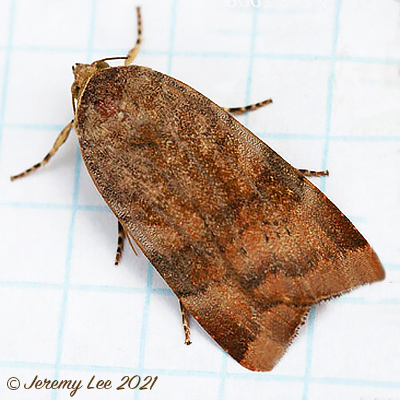
 |
|
Scientific Classifications explained » Amphibians » Ants » Aphids » Bees » Beetles » Birds » Bugs » Butterflies » Caterpillars » Damselflies » Dragonflies » Earwigs » Flies » Frog/Leafhoppers » Fungi » Galls » Grasshoppers » Harvestmen » Hoverflies » Lacewings » Ladybirds » Leaf Mines » Lichens » Mammals » Millipedes » Mosses » Moths » Sawflies » Slugs » Snails » Spiders » Trees & Shrubs » Wasps » Wild Flowers » Woodlice » Postboxes |
UK Nature > Moths > Noctua janthe

Scientific Name: Noctua janthe Common Name: Lesser Broad-bordered Yellow Underwing Noctua janthe, more commonly known as the Lesser Broad-bordered Yellow Underwing, has a wingspan of 30-40 mm. Although it is less variable than some of its close relatives, this moth does show some variation, with many individuals showing a purplish tinge. The thorax has a sharply defined pale buff frontal area, giving a very neat appearance. It frequents woodland, hedgerows and gardens and flies from July to September, when it visits flowers as well as coming to light. The larvae feed on various herbaceous plants, including White Dead-nettle, Broad-leaved Dock and Scentless Mayweed. Occurring throughout Britain, it is commoner in the south. In a recent survey to determine the status of all macro moths in Britain this species was classified as common. |
|

https://www.uknature.co.uk is a website dedicated to showing the immense diversity of UK nature and wildlife. Our vast range of habitats, from lowland arable to snow covered mountains, from storm-ravaged coastlines to peaceful inland freshwater lakes and rivers, from dry, sandy heaths to deciduous and coniferous forests, all these habitats contribute to the abundance of UK nature. We have wild birds in huge numbers either residing or visiting our shores (597 recorded species as at July 2013) and we must also not forget the humble back garden with its grass lawns, flower beds filled with nectar rich flowers, shrubs and trees, all designed to attract huge numbers of insects such as bees, moths, butterflies and hoverflies; and finally the small ponds which provide safe havens for frogs, toads, newts and even slow worms and grass snakes. www.uknature.co.uk is the showcase for my personal passion, photographing uknature in all its glory. I sincerely hope you all enjoy the fruits of my labours. This site and all images contained therein is © Jeremy Lee 2004 - 2025. All Rights Reserved. Site design by Jeremy Lee. Site development & IT Support by Stuart Lee. |